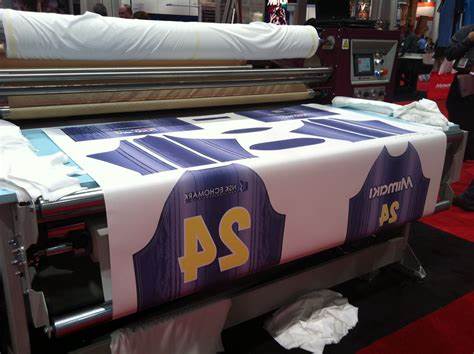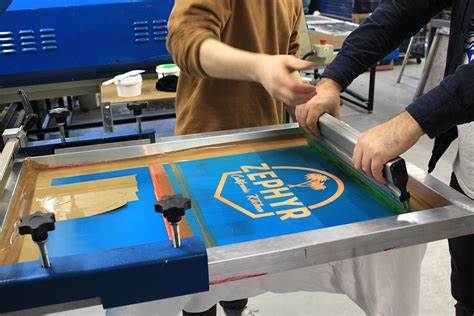Introduction
Sublimation and screen printing are two popular printing techniques used in various industries, including fashion, advertising, and home decor. Both methods have their unique characteristics, advantages, and disadvantages. In this comprehensive guide, we will cover everything you need to know about sublimation and screen printing, from the basics to advanced techniques. By the end of this article, you will have a clear understanding of both printing methods and be able to choose the best one for your needs.
Part 1: Sublimation Printing
1.1 Definition:
Sublimation is a heat transfer process that involves applying a special type of ink to a substrate and then heating it to a specific temperature. The ink turns into a gas and penetrates the fibers of the substrate, creating a permanent, high-quality image that cannot be washed out or faded. Sublimation is commonly used for decorating polyester and polyester blend fabrics, as well as some other synthetic materials.

1.2 Advantages of Sublimation Printing:
Some advantages of sublimation printing include:
Vibrant colors: One of the main advantages of sublimation is that it produces vibrant, high-quality colors that are resistant to fading, even after multiple washes. This is because the ink is embedded into the fabric during the sublimation process, rather than sitting on top of the fabric like with screen printing.
No cracking or peeling: Sublimation inks do not crack or peel off the fabric, even after repeated washing and drying. This makes sublimation a great choice for items that will be subjected to rough handling or frequent laundering, such as sportswear or work uniforms.
No feel of ink: Another advantage of sublimation is that the ink has no texture or feel, so it does not interfere with the comfort or breathability of the fabric. This makes sublimation ideal for use on lightweight, breathable fabrics such as polyester and spandex.
Wide range of designs: Sublimation allows for a wide range of designs, including photographic images, gradients, and multi-colored graphics. This makes it a great choice for creating unique, eye-catching designs that stand out from the crowd.
Quick turnaround time: Sublimation is a fast process that can produce high-quality prints in a matter of minutes. This makes it a great choice for businesses that need to produce large quantities of customized products quickly.
Durable prints: The prints produced by sublimation are durable and long-lasting, even after repeated washing and exposure to sunlight. This makes it a great choice for items that will be used outdoors or exposed to harsh conditions.
1.3 Disadvantages of Sublimation Printing:
Some disadvantages of sublimation printing include:
Limited color options: While sublimation produces vibrant colors, it does have some limitations when it comes to color options. For example, it is not possible to print metallic or fluorescent colors using sublimation inks.
Expensive equipment: Sublimation requires specialized equipment, such as heat presses and printers, which can be expensive to purchase and maintain. This can make it difficult for small businesses or individuals to get started with sublimation.
Limited material compatibility: Sublimation is only compatible with certain types of fabrics, such as polyester and poly/cotton blends. This means that it may not be suitable for all types of textiles, such as cotton or natural fibers.
Complex setup process: Sublimation requires a complex setup process that involves preparing the fabric, printing the design, and applying heat and pressure to the fabric using a heat press. This can be time-consuming and requires some technical skill.
Limited print area: The print area for sublimation is limited to the size of the heat press, which can be a disadvantage if you need to print large designs or cover large areas of fabric.
Limited design complexity: While sublimation allows for a wide range of designs, it is not suitable for very complex designs that require multiple layers or intricate details. This can limit the creative possibilities for designers and artists who work with sublimation.
1.4 Applications of Sublimation Printing:
Sublimation printing is commonly used in various industries, including:
a. Fashion: Sublimation printing is used to create unique and vibrant designs on clothing, accessories, and shoes.
b. Advertising: Sublimation printing is used for promotional items, such as mugs, pens, and phone cases, with company logos or advertisements.
c. Home decor: Sublimation printing is used to create customized home decor items, such as wall art, tiles, and furniture.
Part 2: Screen Printing
2.1 Definition and Process:
Screen printing, also known as silk screening, is a printing technique that involves the transfer of ink through a mesh or screen onto a substrate. The screen is coated with a photosensitive emulsion, which is exposed to light to create a pattern. The unexposed areas of the emulsion are washed away, leaving behind a stencil with the desired pattern. Ink is then pushed through the open areas of the screen onto the substrate, creating a sharp, detailed image. Screen printing is commonly used for decorating cotton, polyester, and other natural and synthetic fabrics, as well as other materials such as glass, metal, and wood.

2.2 Advantages of Screen Printing:
Some advantages of screen printing include:
Larger print areas: Screen printing allows for larger print areas than sublimation, making it a good option for printing complex designs or large logos on t-shirts, hats, and bags.
Cost-effective: Screen printing is generally more cost-effective than sublimation, especially for large orders or bulk production. This makes it a good option for businesses that need to print high volumes of products at a lower cost per unit.
Suitable for a wide range of materials: Screen printing can be used on a wide variety of materials, including cotton, polyester, and blends. This makes it a versatile option for printing on different types of apparel and accessories.
Fast turnaround: Screen printing can produce high-quality prints quickly, making it a good option for businesses that need to fulfill orders quickly.
Durable prints: Screen printed designs are durable and long-lasting, with the ink being cured into the fabric during the printing process. This means that the prints are resistant to cracking and fading over time.
High-quality prints: Screen printing produces high-quality prints that are crisp and clear, with vibrant colors that stand out on the fabric.
2.3 Disadvantages of Screen Printing:
Some disadvantages of screen printing include:
Cost: Screen printing can be expensive, especially if you need to print a large number of items or use high-quality inks and materials. The cost of setting up a screen printing press and purchasing the necessary equipment and supplies can add up quickly. Additionally, each color used in the design requires a separate screen, which can further increase the cost.
Setup time: Screen printing requires a significant amount of setup time, as each screen must be created and aligned properly before printing can begin. This process can take several hours, even for experienced printers, and can add to the overall cost of the project.
Limited color options: Screen printing is best suited for simple, single-color designs. While it is possible to print multiple colors using separate screens, this can be time-consuming and may not produce the desired results. If you need to print complex, multi-color designs, other methods such as digital printing may be more suitable.
Limited print area: Screen printing is ideal for printing large, flat areas, but it may not be the best choice for printing on three-dimensional objects or irregularly shaped surfaces. The size and shape of the object being printed can limit the design possibilities and may require additional preparation work.
Long production times: Screen printing is a slow process that requires time for each step, from preparing the screens to drying the ink. This can result in long production times, especially for large orders or complex designs. If you need to produce a large number of items quickly, another printing method may be more appropriate.
Limited detail: Screen printing is not well-suited for printing fine details or small text. The mesh used in screen printing can create a moire effect on detailed designs, making them appear blurry or distorted. For projects that require intricate details or small text, other printing methods such as digital or flexography may be more effective.
2.4 Applications of Screen Printing:
Screen printing is commonly used in various industries, including:
a. Fashion: Screen printing is used to create graphic designs on clothing, accessories, and shoes.
b. Advertising: Screen printing is used for promotional items, such as posters, banners, and signs, with company logos or advertisements.
c. Home decor: Screen printing is used to create customized home decor items, such as wall art, tiles, and furniture.
Part 3: Choosing Between Sublimation and Screen Printing
To determine which printing technique is best for your needs, consider the following factors:
a. Quality requirements: If you require high-quality, vibrant images with sharp details, sublimation printing may be the better choice.
b. Budget: If you have a limited budget, screen printing is generally more cost-effective, especially for larger print runs.
c. Print size: If you need larger prints, screen printing may be more suitable, as sublimation printing is typically better suited for smaller print sizes.
d. Versatility: Both sublimation and screen printing are versatile, but sublimation printing can be applied to a wider range of substrates, including fabric, plastic, metal, and glass, while screen printing is more suitable for fabric, paper, and some plastic substrates.
e. Color options: If you require intricate designs with multiple colors, screen printing might be a better choice, as it allows for the use of more colors than sublimation printing.
f. Production time: If you need your prints quickly, sublimation printing might be a better option, as it typically has a faster turnaround time compared to screen printing.
g. Environmental impact: If you are looking for a more eco-friendly printing method, sublimation printing is a better choice, as it does not use harmful chemicals or solvents.
Conclusion
By considering these factors, you can make an informed decision on whether sublimation or screen printing is the best technique for your specific needs.
Post time: Dec-14-2023





